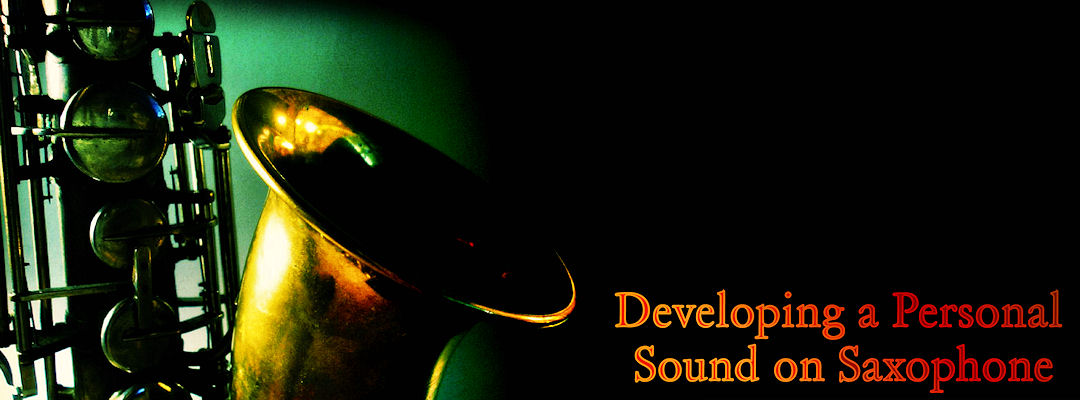
(Original saxophone picture courtesy of Elisabeth D’Orcy)
One of the most common refrains we hear regarding jazz is that the most important thing is to have your own sound. This is pretty much considered the holy grail of jazz playing. With it come the keys to the kingdom. Without it we are condemned to craftman-ship at best, and mere imitation at worst. The highest compliment that can be paid is to be recognized after just a few notes.
So what does it actually mean to have your own sound? Does it mean conceptualizing a particular way of stringing notes together? A unique, original, chord pattern ala’ “Giant Steps changes” or “Charlie Parker changes”? A bag full of musical idiosyncrasies and eccentricities that sets one apart from others? Nope, nope, and nope.
There is one way, and only one way, for a saxophonist to have her own sound; play the instrument with your own voice. Or rather, sing through the instrument with your own voice. There’s a reason why smart phones, cars, and even home entrances are being programmed with voice recognition software. It is because each and every person on this planet has a completely unique and identifiable voice. No one’s voice is quite like yours. This is due to subtle differences in each person’s voice box (larynx) mechanism. Isn’t it amazing how we can sing a LOW pitch, and in a split second change to a pitch several octaves higher.. ALMOST EFFORTLESSLY! We can change the quality of our voice from smooth to rough, from gentle to angry without so much as a thought. If you don’t believe me just have your sweetheart stick a knife in your side and see how quickly your sweet nothings transform.
So how can we transfer this natural vocal talent to the saxophone? How can we develop our own voice on saxophone?
We don’t actually develop a voice. We discover and nurture the voice we already have.. the only voice we will ever have. And that voice is created with the voice box. So the real question is how to practice manipulating the voice box while we are playing saxophone.
Making friends with Low Bb
The key to nurturing one’s natural voice is to exercise the larynx, or voice box, within the context of saxophone playing. In order to do this it is helpful to conceptualize the saxophone as if it had no tone holes drilled into it. Essentially, a saxophone is simply a long metal tube. It is a horn. Just like a trombone, but without the slide. As a skillful manipulator of this metal tubing, we should be able to produce any pitch from a combination of larynx and wind (breath) control. No keys or tone holes should be necessary. The tone holes are more or less a recent invention, essentially a piano grafted onto the original horn (keeping in mind that horns are many thousands of years old, while the piano has been with us a mere 200 years). With tone holes we can play notes in faster succession. But this in no way improves on the basic tonal beauty produced by singing through metal tubing. In fact, the tonal quality produced with regular “fingerings” is vastly inferior to that produced when all of the tone holes are closed and the entire tubing is resonating.
What we need to do is to practice playing the entire horn, all the tubing. The way we do this is to hold all the keys down, fingering a low Bb. When we finger low Bb all the metal tubing, the entire saxophone, is resonating. So we really need to make friends with low Bb. Are we one of those sax players that just sort of reaches down and “touches” the lowest notes, and then quickly moves on before we run out of breath? No way.. that’s not gonna cut it. We need to get down in the mud and live with those low notes. So the first step is to play low Bb, B, C, and C# long and strong (loud) every day, multiple times, over and over. The breath support that it takes to play low Bb needs to be the default breath support that is used throughout the range of the horn, low and high.. In other words, we are always playing low Bb.
Overtone Manipulation (Exercising the Larynx)
Once we’re comfortable producing a big, strong low Bb, B, C, and C#, we can begin exercising our voice box. This is done through overtone manipulation, which essentially means producing various pitches while holding down all the keys on the horn (low Bb). For example: Fingering a low Bb, we can produce in the following order, the overtones middle Bb, middle F, high Bb, high D, high F, double high (altissimo) Ab, double high (altissimo) Bb, double high (altissimo) C, double high (altissimo) D.. so on and so forth.
To start with I recommend playing a low Bb (the root or fundamental pitch). Next continue to finger low Bb, but produce a middle Bb pitch. Keep fingering low Bb and produce a middle F, and then a high Bb. It’s important not to bite down on the reed when reaching for the higher pitches. The bottom lip should be relaxed. The overtones are produced by a combination of breath support (velocity), air direction, and larynx movement. When playing a low Bb, the air should be directed downward toward the floor. When playing middle Bb (while continuing to finger low Bb) the air should be directed straight ahead. When attempting to play the middle F and high Bb, the air should be directed higher up toward the ceiling. One trick is to look in the direction that you want the air stream to go. The air stream tends to follow where the eyes are looking. If you are looking up at the ceiling it is more likely that the air will be directed toward the roof of the mouthpiece and a high note will pop out. Likewise, if you look down toward the floor, it is more likely that you will produce a low note (even if you have the octave key down!).
Be careful not to bite down on the reed when going for high notes. The correct way to create a slight tension on the reed is to pull the corners of your mouth back into a “smiling” position. This produces a taut feel on the reed, but not a vise-like clamp. Pulling the corners back also helps to direct the air upward when playing higher overtones. I recommend standing in front of a mirror when practicing overtones. This way you can see if you are biting down. As you produce the overtones you’ll also notice your “adam’s apple” will move slightly with each new pitch. This is the Larynx making the necessary adjustments to enable the notes to pop out.. just like it does when you speak, sing, or stub your toe.
As you produce each overtone, it’s important to hold them out as long as possible. In this way the Larynx is learning what it needs to do in order to produce that pitch. The larynx is actually memorizing the position it must assume. If you simply “touch” the overtone and then stop, that won’t have the desired effect. The body can only learn through long and slow repetition.
As we produce each overtone it (the overtone pitch) will at first likely be “surrounded” or “embedded” in a tonal cluster. In other words, you will not only produce the desired pitch, but also higher and lower overtones along with it. This is a normal part of the process. When this happens do not stop the air stream and try again. Instead continue holding out the overtone(s), and with your larynx (throat) try to “weed out” the undesired pitches, leaving only the pitch you are trying for. The goal is to produce a “pure”, “undiluted” overtone pitch. Remember, it’s all in the larynx or throat. You can actually feel the pitch in your throat.
Once you are comfortable playing the first three overtones off of a low Bb note, then try the same off of a low B, C, and C#. For example: Finger low B, while producing a low B pitch, then a middle B, middle F#, and high B. Do the same starting on low C and C#.
Overtones should be practiced every day as a warm up. In the beginning I recommend allotting one quarter of your practice session each day. This is an ongoing practice. It is not something that once you learn there is no further need to practice, like for example, with scales or chords. I have been practicing overtones daily for over 20 years. By incorporating overtone exercises as a daily warm up the larynx will become flexible and nimble, allowing you to quickly jump to higher or lower overtones, and to also “slide” between pitches much like a trombone.
Matching Tones
Once we are comfortable producing the first three or four overtones from the fundamental pitches of low Bb, B, C, and C#, we move on to the final step, which is matching tones. **NOTE** Do not move on to this step until you are thoroughly comfortable producing clear, full, undiluted overtones. This can take weeks, months, or years.. how long it takes is inconsequential.
The concept of “matching tones” is to match the tone produced with regular fingerings to the overtone pitch. For example; While fingering a low Bb, sound out a middle Bb pitch (overtone). Now switch to the regular fingering for middle Bb and attempt to match the tone to that of the overtone middle Bb. This means matching the timbre (rough/smooth, bright/dark), the fullness, and the pitch. Try to make the fingered note sound just like the overtone note in every respect. The idea is that your true sound..your warmest, fullest, most resonant sound is produced with the overtone series, when all (or most) of the metal is vibrating, and you are playing from your throat. When we use conventional fingerings we want them to produce a sound as close to the overtone sound as possible.
Close your eyes, and go back and forth playing long tones. First the overtone pitch, then the corresponding fingered pitch. Over and over. It’s a subtle practice. Over time you will unconsciously start to play the regular fingered pitches from your throat, just as with the overtones. In other words, your larynx will treat ANY note you play as if it were producing an overtone.
The main thing is consistent application (practice everyday for a set amount of time, incorporating these practices as a daily warm up), and patience.
Good Luck!
(copyright 2015 gaucimusic.com)
_________
NY Ensemble Classes is a jazz school located in New York City, in the heart of Manhattan. We teach ensemble classes in a very special way, like no one else in the city, read more!






